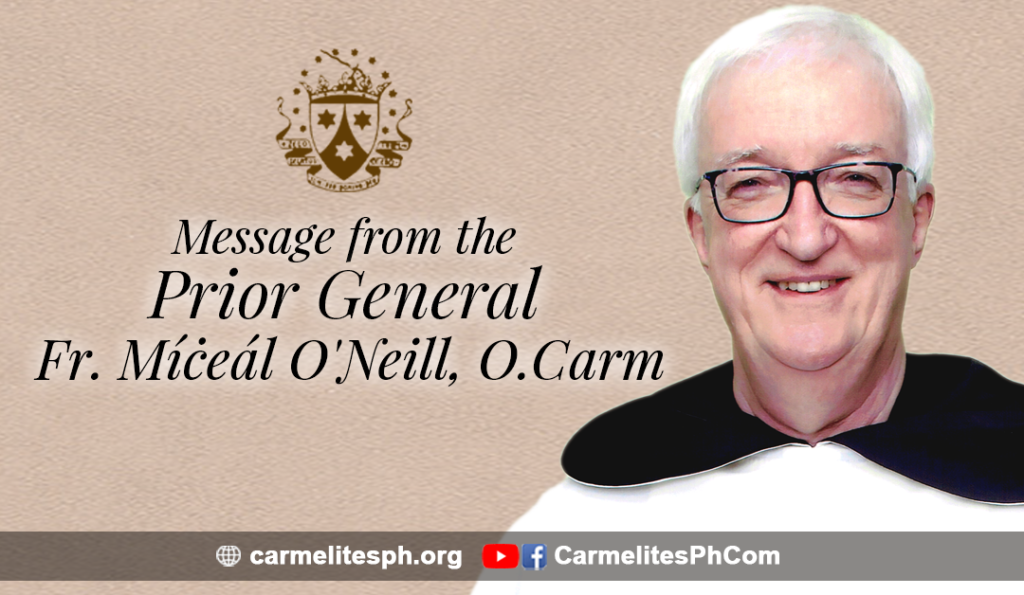
Letter to the Carmelite Family for the Celebration of the
Solemnity of the Blessed Virgin Mary of Mount Carmel
Our feet are standing within your gates, O Jerusalem!
Ps 122, 2
Dear Sisters and Brothers in the Carmelite Family
It is my particular desire this year to draw your attention to the bond that Carmelites have with the land of Jesus’ birth and earthly life and the land in which the Carmelite Order and Tradition was founded. It is the land that we continue to honour in our devotion to Mary, whom we recall and honour as Our Lady of Mount Carmel, the Lady of the Place. It is that land that pilgrims and crusaders longed to visit and to protect. It is a land that today cries out for an end to hostilities and the fulfilment of a dream of peace for the many nations and peoples who are represented among its populations.
The Place Where We Were Founded
Our Marian tradition has in roots in the dedication to Mary of the first oratory built by the hermits in the midst of their cells, close to Elijah’s spring, in one of the peaceful valleys on Mt Carmel. This meant that they were acknowledging her, the Mother of their Lord, as the Lady of the Place. Both oratory and spring, on that mountain in the Holy Land, continue to remind us that our forebears chose to live in allegiance to Jesus Christ, under the loving gaze of Mary and in imitation of her and of the prophet Elijah, whose solemnity we also celebrate in July.
Our forebears were among the many medieval pilgrims who flocked to the Holy Land. Like other pilgrims, they chose to remain there, and eventually sought to form an eremitic community on the slopes of Mt Carmel. Together they lead a life of penance, that is, of ongoing conversion, that they might «live in allegiance to Jesus Christ and serve him from a pure heart and a good conscience» (Rule, 2). The notion of allegiance as conceived and lived out in the Middle Ages, meant that these hermit-brothers of Carmel would have developed a living bond with the Holy Land that was then considered to constitute the actual patrimony and kingdom of their Lord. They committed themselves to remain in this land, in their hermitage, engaged in a spiritual battle (Rule, 18-19) in the service of their Lord.
From Mount Carmel to the Rest of the World
This commitment was put heavily under pressure when, in the 1230s, the political situation in the Holy Land became more precarious and some of the hermits of Carmel, fearing persecution, wished to leave the Holy Land and return to their native countries in Europe and make foundations there. It was not a trivial issue. Felip Ribot, in his The Ten Books on the Way of Life and Great Deeds of the Carmelites, commonly known as The Institution of the First Monks, from the title of its first seven books, gives us a vivid picture of a community chapter on Mt Carmel, in which the brothers discussed whether they could «leave the Holy Land or build houses of the Order outside it». It was so important an issue that they met to discern prayerfully God’s will for them seeking light from the Holy Scriptures. As if this were not enough, the story goes that only after being «warned by Christ and the blessed virgin Mary, his mother, in a dream», did the prior give «permission to some of the brothers to leave the Holy Land and return to their own countries and build monasteries of their Order there» (Book 9, chapter 3).
Whether or not it is historically true, this account shows how medieval Carmelites conceived their relation with the Holy Land. It was not simply their cradle, which they could leave once they grew up. They were bound to remain there by vow.
Eventually the brothers began to leave the Holy Land and settle first in Cyprus and then in various parts of Europe. Finally, in 1291, the whole of the Holy Land came under Muslim rule and the original monastery on Mt Carmel, together with two other foundations in the Holy Land, in Acre and Tyre, was destroyed. Thus the Carmelites were eradicated from Mt Carmel and from the Holy Land. But by now, they had already made numerous foundations all over Europe. Wherever they went, they carried with them the memory of Mt Carmel and the Holy Land and kept hoping that one day they would return. Mt Carmel gave them their name and became their major spiritual symbol. The pilgrimage to the Holy Land undertaken by their forebears now became a parable of their spiritual journey. They held on with some nostalgia to the memory of the Holy Land by taking with them the Rite of the Holy Sepulchre. For many centuries and up to the liturgical reform promoted by the Second Vatican Council, the Rite was the Order’s living bond with the Holy Land. Another way in which they kept alive their relation with the Holy Land was the retention of a Province of the Holy Land in Cyprus, and when even the foundations on that island were lost, the title of Provincial of the Holy Land, that, even though only titular, continued for various centuries to be given to a friar who then had the right to take part in the General Chapter. Some of the early foundations of the Order, even today, include the Latin cross of Jerusalem in the Carmelite crest.
Keeping the Original Spirit Alive
What does the Holy Land represent for the Order today? It certainly reminds us of our origins. But this should be more than a mere sentimental bond with the past. Recalling the Holy Land, we are invited to keep alive the spirit that animated those men who left their countries in pilgrimage to the Holy Land and vowed to settle there, living in allegiance to Jesus Christ. These three aspects, being on pilgrimage, remaining, and living allegiance to Christ lie at the core of our vocation. They no longer have the concrete local meaning that they had for the first Carmelites. But we still see ourselves as people on a journey, people who need a stable abode, and people completely dedicated to Christ and to his service.
A Journey of Transformation in Community
Our journey is above all an interior one, “a journey of transformation.” This is the core of our vocation and mission. But there is also another aspect. As the pilgrimage of our hermit fathers to the Holy Land was transformed into the itinerancy of mendicant friars, so journeying for us today implies our walking side by side with the men and women of our times, sharing their joys and their difficulties, sharing with them Christ and the richness of our spirituality.
With the transformation of the order from hermits to mendicant friars, settling down in one place, and even more establishing themselves exclusively in the Holy Land, was no longer the case. But the idea of «remaining», of having a stable abode, persisted and is still part of our vocation. The Rule calls us to remain in our cells, «meditating day and night on the Law of the Lord and keeping vigil in prayer» (Rule, 10). The spirituality of remaining in our cell has always been an important aspect of our spirituality and it needs to be fostered.
Abiding in our cell reminds us of Jesus’ own invitation to abide in him (cf. Jn 15: 4-10). God is our true abode, whether we are in the solitude of our cell, in community, or serving the people. The idea of settling down, «remaining», having a stable abode, reminds us also of our call to community. The first Carmelite community on Mount Carmel bore the image of the early community of Jerusalem and had it is psyche the idea of being a representation of the New Jerusalem.
These aspects form the concrete way in which we, as Carmelites, are called to live our allegiance to Jesus Christ. He is and remains the foundation stone of Carmel that cannot be replaced. As we celebrate the solemnity of Our Lady of Mt Carmel and that of the Prophet Elijah, and recall our origins on Mt Carmel in the Holy Land, we are invited to commit ourselves to live in a renewed way the propositum of our founding community.
A Question of Identity
The living memory of Mount Carmel located in the Holy Land is manifested in our continued use of that name when referring to who we are. We continue to hold that mountain in our hearts and minds. This living memory reminds us that we are still a people of that mountain, even as we find ourselves caught up in the busy-ness of the city. This tension is life-giving. It calls us back again and again to our identity as contemplatives. For that reason, we see in our saints, Angelo Paoli, the father of the poor, Teresa of Avila the wandering foundress, John of the Cross, poet and spiritual companion, Edith Stein, professor and martyr, and Titus Brandsma, a man for all season, Carmelites all of whom lived with this tension, all of whom were lovers of the name Mount Carmel.
Our July celebrations take us back, as if on a spiritual pilgrimage, to Mt Carmel and the Holy Land. This year in which we have witnessed again political unrest and war in the Holy Land, as we recall the special bond that binds us to that land, our heart goes out to all the people involved in that difficult situation. We earnestly pray that a just solution be found so that all may enjoy stability and safety and live in peace. We are also saddened by the continuous exodus of Christians from the Holy Land and from the whole Middle East, due to the great difficulties in which they live. We want to support them by our prayers and in any other possible way.
Our Prayer for Peace
As we spiritually share the joy of our pilgrim fathers and of the pilgrims of every age, whether Jews, Christians, or Muslims, on arriving in the Holy Land, and sing with them: «Our feet are standing within your gates, O Jerusalem!» (Ps 122: 2), we listen attentively to the psalmist as he exhorts us: «Pray for the peace of Jerusalem» (Ps 122: 3). Let that be our special prayer intention this year as we celebrate Our Lady and St Elijah. While on the one hand we often think that it would be wonderful if the Carmelite Family and particularly the friars had a greater presence in the Holy Land, let us remember that we are there in the presence of the two communities of the Istituto di Nostra Signora del Carmelo, the Italian Carmelite Congregation founded by Beata Teresa Scrilli, and the women and men of the Discalced Tradition. Their safety and the success of their work is also a reason for us to pray.
As we renew our devotion to Mary, we honour her again as the Lady of the Place and place the people of the Holy Land under her motherly care in the confidence that the more fervently we show our desire for peace, that peace that only our God can give, then the surer we are that our prayer will be heard, and there will be peace.
A blessed and joyful Solemnity of Our Lady of Mount Carmel to all!
Fr. Míċeál O’Neill, O.Carm.
Prior General
- Preparing to Ascend
 Text and photo by Maria del Espiritu Deciding to enter the narrow and steep road and staying on it is …
Text and photo by Maria del Espiritu Deciding to enter the narrow and steep road and staying on it is … - Come and See
 Easter Message from the Prior Provincial and Council Dear brothers and sisters, How are we to celebrate Easter joy with …
Easter Message from the Prior Provincial and Council Dear brothers and sisters, How are we to celebrate Easter joy with … - Bro. Arnoldus Josefus Bekkering van Vugt, a.O.CarmBro. Arnoldus Josefus Bekkering van Vugt, a.O.Carm February 5, 1933 – April 6, 2019 And we know that in all …
Bro. Arnoldus Josefus Bekkering van Vugt, a.O.Carm Read More »